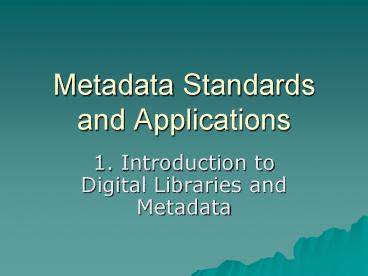Metadata Standards and Applications - PowerPoint PPT Presentation
Title: Metadata Standards and Applications
1
Metadata Standards and Applications
- 1. Introduction to Digital Libraries and Metadata
2
Intro to Digital Libraries
- Traditional library characteristics
- Digital library characteristics
- How does the environment affect the creation of
metadata? - Differences
- Similarities
3
Traditional Libraries
- Firm commitment to standards
- AACR2--specifications for metadata content
- MARC 21--specifications for metadata structure,
encoding and packaging - A variety of syntactical bindings available
- Agreements on quality expectations
- Tradition of sharing, facilitated by
bibliographic utilities - Available documentation and training
4
Digital Libraries
- No dominant content standard
- A variety of formats (or schemas or element
sets) - Some emerging federated agreements, mostly in
the world of digital libraries attached to
traditional libraries (ex. DLF) - Very low (if any) quality expectations!
- Emerging (but still spotty) basis for sharing
(OAI-PMH) - Very little documentation and training available
(mostly local and difficult to re-use)
5
Environmental Factors
- Differences
- Players New world of metadata not necessarily
lead by librarians - Goals Competition for users critical for
sustainability - Resources No real basis for understanding
non-technical needs (including metadata creation
and maintenance) - Many levels of content responsibility (or none)
6
Environmental Factors
- Similarities
- Its about discovery (and access, and use, and
meeting user needs) - Pressure for fast, cheap and good enough (also
rich, scalable, and re-usable--is that a
contradiction?) - Wide variety of materials and services
- Maintenance needs often overlooked
7
What IS Metadata?
- Some possibilities
- Data about data (or data about resources)
- Structured information that describes, explains,
locates, and otherwise makes it easier to
retrieve and use an information resource. - A management tool
- People, stuff, and agreements
- (indecs)
8
Functions of Metadata
9
Types of Metadata
- Administrative
- Descriptive
- Access/Use
- Preservation
- Structural
- Other?
10
Administrative Metadata
- Sometimes called Meta-metadata
- Who created this information?
- When was it created?
- When were links last checked?
- Other update transactions?
- Review or approval (by cataloger, or other
responsible party)
11
Descriptive Metadata
- Title, author, human-readable description of a
resource - Subject or topical information
- Genre and format of the resource
- Relationships with other resources (version,
parent/child, etc.)
12
Access/Use Metadata
- Where is the resource? Is it in a place open to
me? - Are there restrictions on the use of the
resource? - Do I have the hardware/software to use the
resource? - What can I do with this resource?
13
Preservation Metadata
- Designed to ensure that the information the
resource contains remains accessible to users
over a long period of time - Records details about format migration and data
refreshment - Tracks versions used for different kinds of
access and display - Allows a variety of approaches to the problem of
maintaining resources over time
14
Structural Metadata
- No single standard or best practice governs
structural metadata creation - Ties the components of a complex or compound
resource together and makes the whole usable - Enables flexible and local approaches to
presentation and navigation - Various approaches to sharing structural metadata
exist (METS perhaps the best known)
15
Cataloging and Metadata
- How are they related?
- Underlying models for cataloging based on AACR2
and MARC 21 - Underlying models for metadata not well
integrated with schemas - DC Abstract model an exception
- FRBR the model for RDA
- Most metadata models roughly based on
attribute/value pairs - ltpropertygt ltvaluegt
16
One BIG Difference ...
- Catalogers most often are attempting to fit new
items into an already existing world of
materials-- - The structure already exists, as do the rules for
describing - Metadata practitioners are generally working with
aggregated stuff, attempting to find a way to
make it accessible - Involves broad understanding, ability to work
with others to make decisions that work for whole
projects or domains
Thanks to Marty Kurth for these insights
17
Exercise
- Examine the three digital library sites below,
and be prepared to discuss differences in user
approach and experience. How is metadata used in
these sites? - Alsos Digital Library for Nuclear Issues
(http//alsos.wlu.edu/default.aspx) - CSUN Oviatt Library Digital Collections
(http//library.csun.edu/Collections/SCA/digicoll.
html) - Birdsource (http//www.birdsource.org/)






























